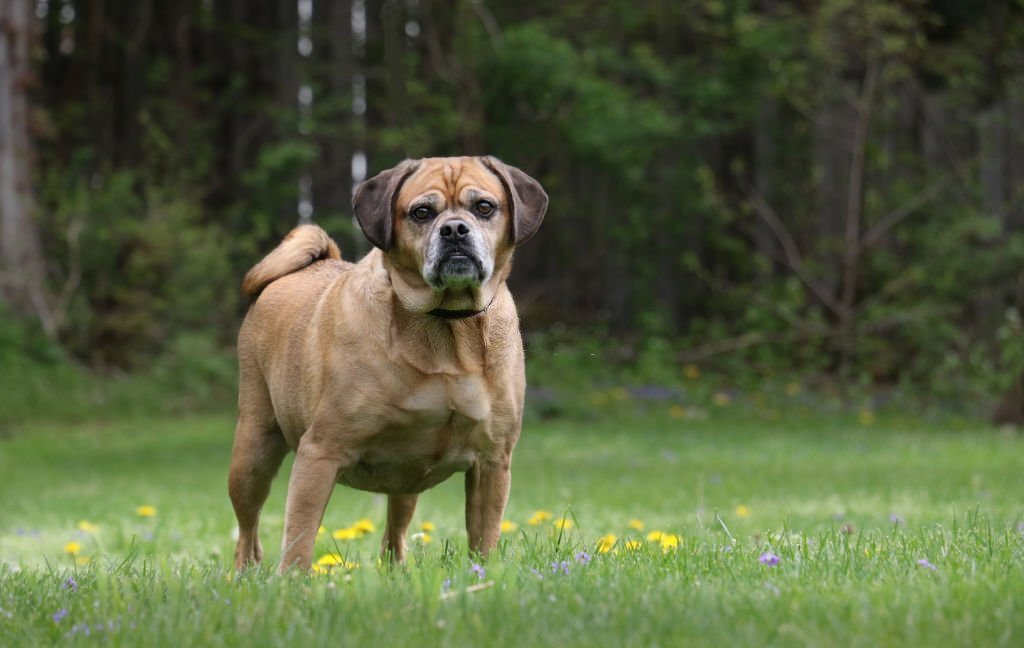Interested in finding out more about puggle dogs? Everything you need to know about this well-known breed, including their size, weight, lifespan, temperament, and more, is covered in our in-depth guide. Our article covers all the crucial information, whether you’re thinking about bringing a puggle into your family or are simply interested in learning more about this endearing breed.
I – What is a puggle dog?
1. Definition puggle dog
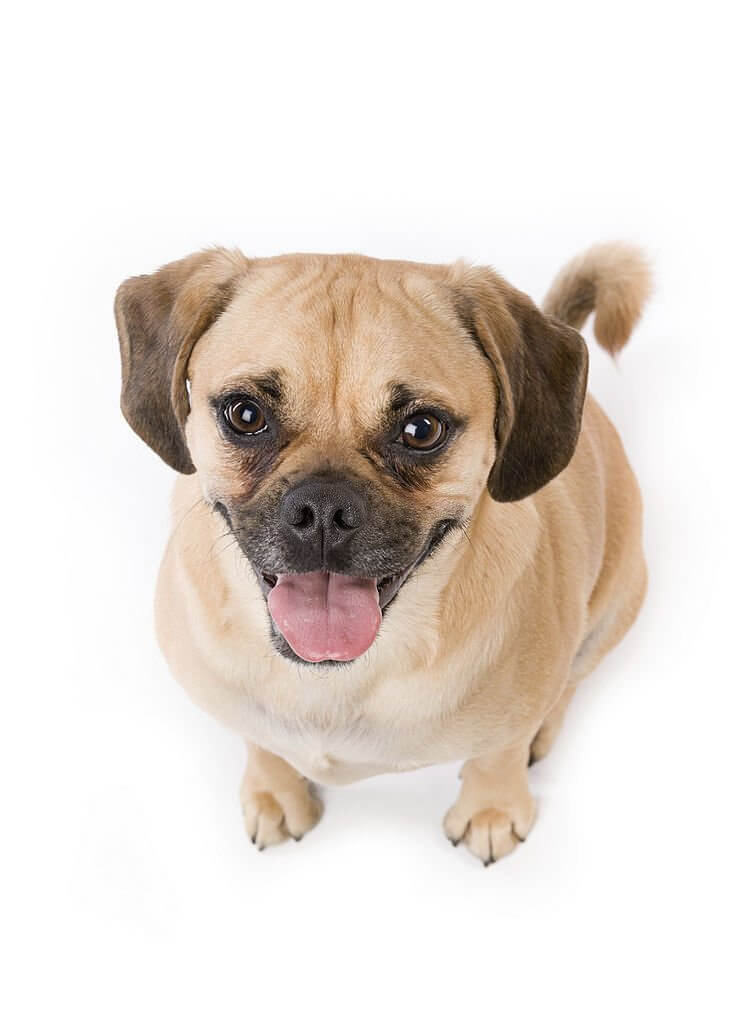
| 10-15 inches | |
| 14-30 pounds | |
| 10-15 years | |
| small (0-25 lbs.) | |
| • familie • children • dogs |
|
| • outgoing • friendly • playful • willful |
|
| medium | |
| normal | |
| medium | |
| active | |
| frequent | |
| low | |
| hybrid | |
LENGTH/ TEXTURE | short |
| • red • gold / yellow • fawn • black |
|
| • bicolor • sable |
|
| • needs extensive grooming • a propensity to chew • apartment-friendly • strong tendencies to be loyal • good hiking partner |
|
The puggle dog is a small to medium-sized dog, standing between 10 and 15 inches tall at the shoulder and typically weighing between 15 and 30 pounds. Its physical characteristics combine those of the Pug and the Beagle, though they may differ depending on the genetics of each individual dog. A black mask covers the face of the puggle, which typically has a short, smooth coat that is fawn, black, or tan in color.
The puggle may display a variety of temperaments and traits from both of its parent breeds as a result of its mixed breeding. They make great family pets because of their well-known amiable, affectionate, and playful personalities. They are also energetic and need playtime and exercise on a regular basis to stay healthy and happy.
Although the puggle is a well-known and adored breed, the American Kennel Club and other significant dog organizations do not recognize it as a purebred breed. Instead, because it was created by purposefully mating two different purebred dog breeds, it is referred to as a hybrid or designer breed.
2. Puggle Size
Puggle dogs are a small to medium-sized breed, but they can grow to be larger or smaller than their parents, depending on their genetic makeup. They weigh between 15 and 30 pounds and stand between 10 and 15 inches tall at the shoulder on average. Some pugs, though, might fall outside of this range.
The Pug is a small breed, while the Beagle is a medium-sized breed, so the size of a puggle will depend on the size of its parent breeds. The puggle may be smaller if the parent pug is smaller in stature. On the other hand, a larger Beagle parent may result in a larger puggle.
Puggles’s weight and height can also vary depending on things like their diet, level of exercise, and general health. To maintain a healthy weight and advance good health, it’s crucial to give your pug a balanced diet and regular exercise.
To make sure you are getting a puggle with the desired size characteristics, it is crucial to research the breeders and their breeding practices if you are looking for a specific size of pug. There may be variations in size and appearance among individual puggles because they are a designer breed and are not accepted as a purebred by major canine organizations.
3. Puggle Weight
Puggle dogs typically weigh 15 to 30 pounds on average, with the range being 15 to 30 pounds. Individual puggles’ weight, however, may vary based on things like genetics, diet, exercise, and general health.
Puggles are a hybrid breed created when a Pug and a Beagle were crossed. With Pugs being a small breed and Beagles being a medium-sized breed, their parent breeds’ sizes may have an impact on how much they weigh. The size and weight of the puggle may be smaller if the Pug parent is smaller, while the size and weight of the puggle may be larger if the Beagle parent is larger.
Maintaining a healthy weight for your dog through a balanced diet and regular exercise is crucial to fostering good health and preventing obesity-related health issues. Given that pugs are known for loving food, it’s crucial to keep an eye on how much of it they consume and to feed them a balanced diet that meets their nutritional needs without overeating.
To make sure you are getting a healthy dog who is not overweight or predisposed to health problems related to obesity, it is crucial to research breeders and their breeding practices if you are thinking about getting a pug. Maintaining your puggle’s weight in a healthy range and fostering general health and wellbeing depend on regular exercise and a balanced diet.
4. Puggle Lifespan
In line with other small to medium-sized dog breed average lifespans of 10 to 15 years, pugs have a similar lifespan. Individual puggles, however, may live longer or shorter lives based on a variety of variables, including genetics, diet, exercise, and general health.
Puggles are a hybrid or designer breed that combine traits from both of their parent breeds’ physical and behavioral traits. Beagles are prone to obesity and known to have respiratory problems, which can both shorten a puggle’s lifespan. In order to prevent health problems and lengthen your puggle’s life, it’s crucial to maintain a healthy lifestyle for them through a balanced diet, regular exercise, and veterinary checkups.
Your puggle needs a balanced diet that satisfies their nutritional requirements, regular exercise, and mental stimulation to help ensure a long and healthy life. Puggles are playful and active dogs, so they need to play and exercise every day to stay happy and healthy. In order to identify any health issues early and address them before they worsen, it’s crucial to maintain regular veterinary checkups.
The overall level of care a puggle receives can have a significant impact on how long they live. Puggles can live long, happy lives if given the right care and attention.
5. Puggle Temperament
Puggles make excellent family pets because of their playful, affectionate, and friendly disposition. Puggles, a cross between the Pug and the Beagle, can inherit a variety of characteristics from each of their parent breeds, but they typically have a sociable and outgoing personality.
Puggles are well known for being sociable and appreciating both human and animal company. They make a great choice for families because they typically get along well with kids and other dogs. Additionally, they have a propensity to follow their owners around and lust after love and attention.
Puggles are renowned for their exuberant and playful personalities. They adore playing and taking part in games like fetch, tug of war, and chasing after toys. They can, however, also be very relaxed and enjoy spending time on the couch with their owners.
The stubbornness of pugs is one potential problem. Puggles may in part inherit the independence and stubbornness exhibited by beagles and pugs, respectively. Although they can be challenging to train at times, they can be well-behaved and obedient pets with persistence and consistent training.
Puggles are generally a sociable, loving, and playful breed that makes wonderful family pets. They take pleasure in playing, being around people, and curling up on the couch. Puggles can make devoted and adoring companions with the right socialization, training, and care.
6. Puggle Colors
Puggles can be found in a variety of hues and patterns, which their parent breeds, the Pug and the Beagle, may have influenced. Puggles don’t have a set or recognized color, but some hues and patterns are more typical of the breed.
Fawn, a light brown or tan color, is one of the hues most frequently seen in pugs. From a pale beige to a darker, reddish-brown shade, this color can be found. Black is another common color that can be used alone or combined with other hues such as white, fawn, or others.
Puggles can also be found in brindles, which have black or dark brown stripes on a lighter background. Puggles with brindle coloring can inherit this trait from their Beagle parent, as this pattern is frequently seen in Beagles.
Puggles can also be found in white, cream, silver, chocolate, and tan, among other hues and patterns. Some pugs may have a combination of hues, such as brindle and white, brindle and black, or fawn and white.
Puggles may have particular colors or patterns, but they are not purebred dogs, and there are no breed standards for color or pattern. This is important to remember. Furthermore, a puggle’s color may not be a good predictor of their temperament or personality.
Puggles can be found in a wide variety of hues and patterns, with fawn and black being the most popular. Puggles, regardless of their coat color, can make wonderful and lovable companions whether you prefer a solid color or a mix of patterns.
7. Puggle Characteristics
Puggles make excellent family pets because of their friendly, outgoing, and social personalities. Puggles are a cross between the Pug and the Beagle breeds, and while they can inherit a variety of personality traits from their parents, they typically have a loving and playful nature.
The friendliness of puggles is one of their most distinguishing character traits. They typically get along well with kids and other animals, and they like being around people. They frequently follow their owners around and long for love and care.
Puggles are renowned for being playful and vivacious. They adore playing and taking part in games like fetch, tug of war, and chasing after toys. They can, however, also be very relaxed and enjoy spending time on the couch with their owners.
Puggles are loyal, which is another trait. They are known to develop close relationships with their owners and to like being around them. If left alone for extended periods of time, they might experience separation anxiety, so it’s crucial to show them lots of love and attention.
The stubbornness of pugs is one potential problem. Pugs may inherit this trait to some extent since Beagles and Pugs both have a tendency to be stubborn at times. Although they can be challenging to train, they can be made into well-mannered and obedient pets with persistence and consistent training.
II – Examples of puggle dog
1. Most popular puggle dogs
Popular mixed breed puggles are renowned for their outgoing and amiable personalities. Although pugs can have a wide range of hues and patterns, fawn and black have recently become two of the most popular options.
Puggles in fawn and black are very popular among dog owners. Black pugs can look sleek and fashionable, while fawn pugs can be prized for their warm and welcoming coloring. Puggles are well-known for their lovable personalities, regardless of their color, making them a popular choice for both families and individuals.
It’s crucial to remember that a puggle’s coloring doesn’t always reflect their temperament or personality when thinking about adding one to your family. The sociable and playful characteristics that make Puggles such wonderful companions can be seen in a variety of colors.
It’s crucial to pick a reputable breeder or rescue group and to give your pug plenty of love, care, and attention regardless of whether you prefer a fawn, black, or any other color. Your puggle can thrive and grow to be a beloved member of your family for many years with the right environment and care.
1.1 Fawn Puggle

Puggles with fawn coats are frequently described as having light brown or tan coats. The hue can range from a light beige to a darker, reddish-brown shade. Black facial markings are another possibility for fawn pugs, and they can give them a distinctive and endearing appearance.
1.2 Black Puggle

In contrast, black pugs have a solid black coat that may also be white, fawn, or another color. Some black pugs might also have white feet or a chest, giving them an even more distinctive look.
2. Puggle Puppies
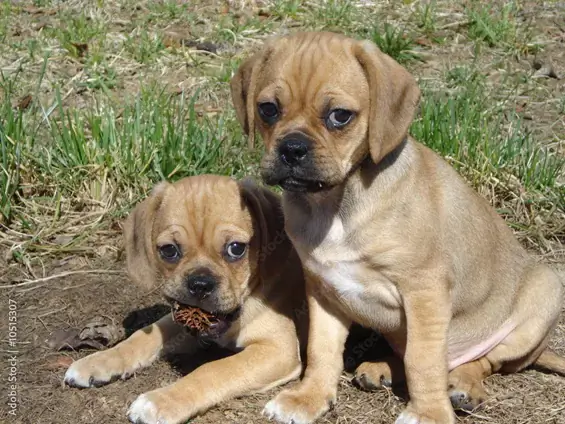
Puggle puppies, with their large eyes, wrinkly faces, and playful personalities, are adorable and hard to resist. Puggle puppies have the following characteristics that prospective owners should be aware of:
- Size: When they are 8 to 12 weeks old, pugilistic puppies typically weigh between 5 and 10 pounds. Depending on the size and genetics of their parents, they can gain up to 15 to 30 pounds.
- Puggle puppies may have a short, smooth coat with little grooming required. They can have solid or blended coats in a range of colors, including fawn, black, white, and tan.
- Puggle puppies are renowned for their sociable and amiable dispositions. They enjoy being the center of attention and enjoy playing and interacting with people and other animals.
- Pug puppies can be stubborn at times, which makes training them difficult. It is advised to use consistent and encouraging training techniques to help the animals develop good manners and obedience.
- Puggle puppies need to be socialized in order to grow up to be well-adjusted, self-assured adults. Early exposure to people and other animals can aid in the development of social skills and lower the risk of behavioral problems.
- Health: Puggle puppies are susceptible to conditions like allergies, ear infections, and dental issues. It’s critical to give them the proper attention, which includes regular veterinary checkups, a balanced diet, and exercise.
They are adorable and endearing, but to help them grow into happy and healthy adult dogs, they need the right care, training, and socialization. Puggle puppies can make wonderful companions for many years if given the proper care and attention.
2. Full-grown Puggle
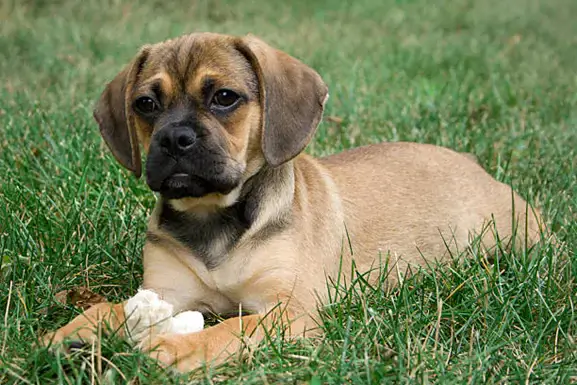
Puggles are typically small to medium-sized dogs when fully grown, standing between 10-15 inches tall and weighing between 15 and 30 pounds. These specifics pertain to puggles that are fully grown:
- Puggles have a short, smooth coat that requires little maintenance. They can have solid or blended coats in a range of colors, including fawn, black, white, and tan.
- Puggles are renowned for their outgoing and amiable dispositions. They are sociable dogs who enjoy interacting with people and other animals, and they typically get along well with kids. They can be animated and playful, but they also like to relax on the couch with their owners.
- Due to their short snouts, pugs are susceptible to certain health problems like allergies, hip dysplasia, and respiratory issues. It’s critical to give them the proper attention, which includes regular veterinary checkups, a balanced diet, and exercise.
- Training: Training pugs can be difficult at times because of their stubborn nature. It is advised to use consistent and encouraging training techniques to help the animals develop good manners and obedience.
- Puggles need to be socialized in order to grow up to be well-adjusted, self-assured adults. Early exposure to people and other animals can aid in the development of social skills and lower the risk of behavioral problems.
- Lifespan: Depending on their health and care, pugs can live for 10 to 15 years.
Puggles are generally sociable and friendly dogs that make wonderful companions for both families and single people. They can live long, healthy lives with the right care and attention, delighting and adoring their owners for many years to come.
4. How big do Puggles get
A typical Puggle can weigh between 14 and 30 pounds and stand between 10 and 15 inches tall at the shoulder. The Pocket Puggle, also known as Miniature Puggles and Toy Puggles, is the newest thing because smaller dogs are becoming more and more in demand.
III – Life expectancy of a puggle
1. The lifespan of a puggle
Puggles typically live between 10 and 15 years, which is a long lifespan for a small to medium-sized dog. However, a puggle’s lifespan can be impacted by a number of factors.
- Genetics: Puggles, like all dogs, may have a genetic predisposition to specific health problems. Puggles frequently experience allergies, hip dysplasia, and respiratory issues as a result of their short snouts. Choosing a puggle from a reputable breeder with a long history of healthy breeding can help lower the risk of genetic health problems.
- Exercise and diet: Giving your pug a healthy diet and regular exercise can help them stay in good general health. Maintaining your pug at a healthy weight is crucial because obesity can cause a number of health issues in dogs, such as joint problems and heart disease.
- Veterinarian care: Routine examinations by a veterinarian can help identify any health problems early on, enabling prompt treatment and better results. Maintaining the health of your pug requires annual exams, vaccinations, and preventative care such as flea and tick control.
- Lifestyle: A puggle’s way of life can have an impact on how long they live. Giving them a secure and stimulating environment with lots of chances for interaction and exercise can help them feel less stressed and improve their general wellbeing.
Puggles can live long, healthy lives if given the right care and attention. It’s crucial to give them the support and care they require so that they can lead the best lives possible.
2. What do Puggles usually die from the disease?
Puggles, like all dogs, are prone to a number of medical conditions that may cause them to pass away. Some of the puggles’ typical health issues include:
- Puggles are susceptible to respiratory conditions like brachycephalic airway syndrome because of their short snouts, which can make it difficult for them to breathe. Respiratory distress, pneumonia, and other related complications can result from this.
- Issues related to obesity: Puggles have a tendency to become obese, which can cause a number of health problems like joint pain, heart disease, and diabetes. These ailments may shorten a puggle’s life and even cause their demise.
- Cancer: Puggles, like all dogs, are susceptible to developing cancer, which, if not caught and treated in time, can be fatal.
- Puggles may experience age-related health problems as they grow older, including cognitive impairment, arthritis, and other conditions that can lower their quality of life and even cause death.
To help lower the risk of these and other health issues, it’s crucial to give your pug regular veterinary care, a nutritious diet, and regular exercise. Any health issues that do arise can often be resolved more successfully with early detection and treatment.
3. How to prolong the life of a puggle dog?
You can do a number of things to keep your pug healthy and happy and to help it live longer:
- Provide a healthy diet: Feeding your puggle a balanced diet with high-quality proteins, healthy fats, and essential nutrients can help maintain their overall health and wellbeing.
- Regular exercise: Providing your puggle with regular exercise can help maintain their weight, reduce stress, and promote overall health. Daily walks and playtime can help keep your puggle physically and mentally healthy.
- Regular veterinary care: Regular check-ups with a veterinarian can help detect and treat any health issues early on. Annual check-ups, vaccinations, and preventative care can help maintain your puggle’s health and wellbeing.
- Dental care: Dental health is important for dogs, and puggles can be prone to dental issues such as tartar buildup and gum disease. Regular teeth brushing and professional cleanings can help maintain your puggle’s dental health.
- Environmental enrichment: Providing your puggle with a stimulating environment that includes plenty of socialization and mental stimulation can help reduce stress and promote overall well being.
- Avoiding common hazards: Puggles can be prone to certain hazards such as overheating due to their short snouts, and toxicity from common household items such as chocolate and certain plants. It’s important to be aware of these hazards and take steps to prevent them.
You can help extend your puggle’s life and make sure they live a happy and healthy life by following these instructions and giving them the care and attention they require.
IV – How much does a Puggle cost
1. A price to own a Puggle
A puggle’s price can vary depending on a number of variables, including the breeder, the area, and consumer demand. Puggles typically cost $500 to $2000, though some breeders may charge even more. There might also be extra expenses for things like veterinary care, food, toys, and other supplies.
When buying a pug, it’s important to exercise caution and conduct research to find a reputable breeder. Reputable breeders guarantee the health of their puggles, give them vaccinations, and make sure they’re happy and well-socialized. Avoid buying from backyard breeders or puppy mills as they might not give their dogs the care they need and might not be honest about any health issues.
A puggle can also be adopted from an animal shelter or rescue group. Many rescue organizations offer veterinary care and other essential services to ensure the health and wellbeing of their animals, and adoption fees are typically lower than buying from a breeder.
Overall, the cost of a puggle can vary, but it’s crucial to take into account the ongoing costs of dog ownership, such as veterinary care. Long-term savings and a loyal companion for many years can be obtained by making an investment in a healthy and socialized pug.
2. Other fees and expenses
There are additional fees and costs that owners should budget for in addition to the initial cost of buying or adopting a pug. These consist of:
- Veterinary care: Puggles require regular veterinary care, including vaccinations, routine check-ups, and preventative care. In the event of illness or injury, veterinary bills can quickly add up.
- Food and supplies: Puggles require a healthy and balanced diet, as well as toys, bedding, and other supplies. Owners should be prepared to purchase food and supplies on an ongoing basis.
- Grooming: Puggles have a short, dense coat that requires regular brushing and occasional baths. Owners may also need to trim their puggle’s nails and clean their ears on a regular basis.
- Training and socialization: Puggles are intelligent and sociable dogs, but they can be prone to certain behavioral issues if not properly trained and socialized. Owners may need to invest in obedience training classes or work with a professional trainer to address any issues.
- Boarding and pet sitting: If owners need to travel or are unable to care for their puggle for a period of time, they may need to pay for boarding or pet sitting services.
- Emergency expenses: In the event of an emergency, such as a sudden illness or injury, owners may need to pay for emergency veterinary care, which can be expensive.
To ensure that their puggle receives the best care and attention possible, owners must plan for these ongoing costs and allocate funds accordingly.
V – Puggle Dog Mixes
A Pug and a Beagle were crossed to create the well-known mixed breed dog known as the Puggle. Other puggle mixes, however, have grown to be more and more well-liked in recent years.
Puggle mixes may provide a special blend of traits and characteristics that appeal to dog owners. Before bringing a mixed breed dog into your home, as with any mixed breed dog, it’s important to learn about its particular needs and traits.
1. Bugg dog
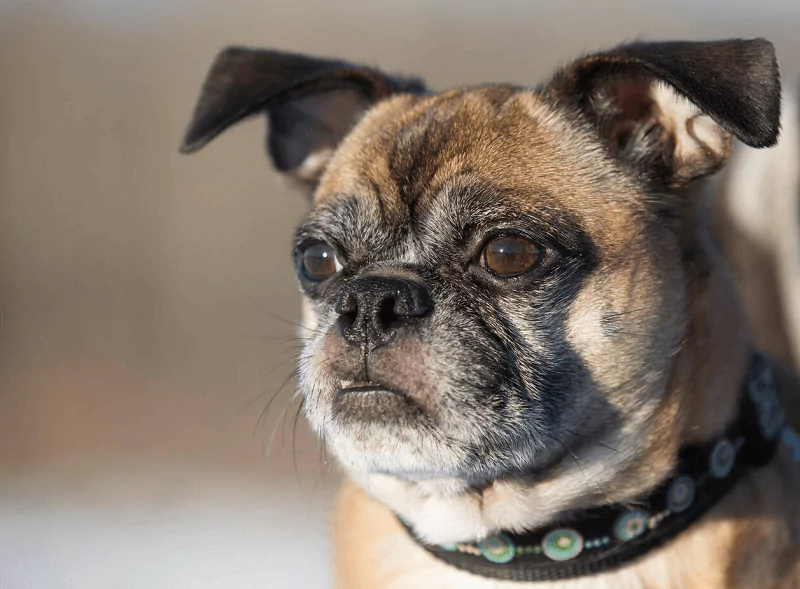
The Bugg, a Pug and Boston Terrier hybrid, is one well-known Puggle mix. Small, devoted dogs called Buggs are renowned for their exuberant and playful personalities. They typically get along well with kids and other animals, and they have a short, smooth coat that is simple to maintain.
A Pug and a Boston Terrier were crossed to create the well-known mixed breed dog known as the Bugg. They are small dogs, usually weighing 10 to 25 pounds and standing between 10 and 17 inches tall. Buggs make wonderful family pets because of their well-known amiable and playful personalities.
The short, smooth coat of a Bugg is simple to care for. They are available in a range of hues, such as black, brindle, fawn, and white. Some Buggs might have the recognizable white “tuxedo” markings that Boston Terriers frequently have.
Although Buggs are typically healthy dogs, they can occasionally develop certain health problems that Boston Terriers and Pugs share. These might include eye issues, skin allergies, and breathing problems. To make sure that your Bugg is healthy, it’s essential to schedule routine veterinary checkups.
Dogs like Buggs are extremely sociable and enjoy being around people. They get along well with kids and other animals, but they might be leery of strangers. They are known for having playful and vivacious personalities and need light exercise to remain healthy and content. Usually, their exercise requirements can be satisfied by daily walks and time spent playing in a fenced yard.
2. Chuggle dog

The Chug (Chihuahua Pug Mix), or Chuggles, is another puggle mix. Chuggles are energetic little dogs who enjoy playing. They can be wary of strangers but are affectionate and devoted to their owners. They need very little grooming and have a short, smooth coat that comes in many different colors.
This diminutive breed typically measures between 6 and 12 inches tall and weighs between 8 and 15 pounds. They make wonderful companions for those who enjoy lap dogs and are known for their adorable and cuddly appearance.
Chuggles have a short, smooth coat that comes in black, brown, fawn, and white, among other colors. Their tail is curly, and they have a rounded head with big, expressive eyes. Chuggles are perfect for apartment living because of their small size; they don’t need a lot of room to be content.
Chuggles is a mixed breed, so he or she could get health problems from either parent breed. They are more likely to experience respiratory problems, dental issues, and allergies. It’s crucial to have regular veterinary checkups to ensure their wellbeing and identify any issues early.
Chuggles is a loving dog who enjoys being around people. They get along well with kids and other animals, but they might require some socialization before they feel at ease around strangers. They need daily exercise to stay healthy and happy because they are playful and vivacious. They can get the exercise they require by going for daily walks and playing with their toys in a fenced yard.
3. Puggleman (Pug Doberman)
The Pug-Doberman Pinscher cross is known as the Puggleman. These dogs have a distinctive look, with the lean, athletic build of a Doberman and the stocky body of a Pug. Although highly intelligent and trainable, they occasionally exhibit strong will. Pugglemans typically get along well with kids and other animals, and they need regular brushing and light exercise.
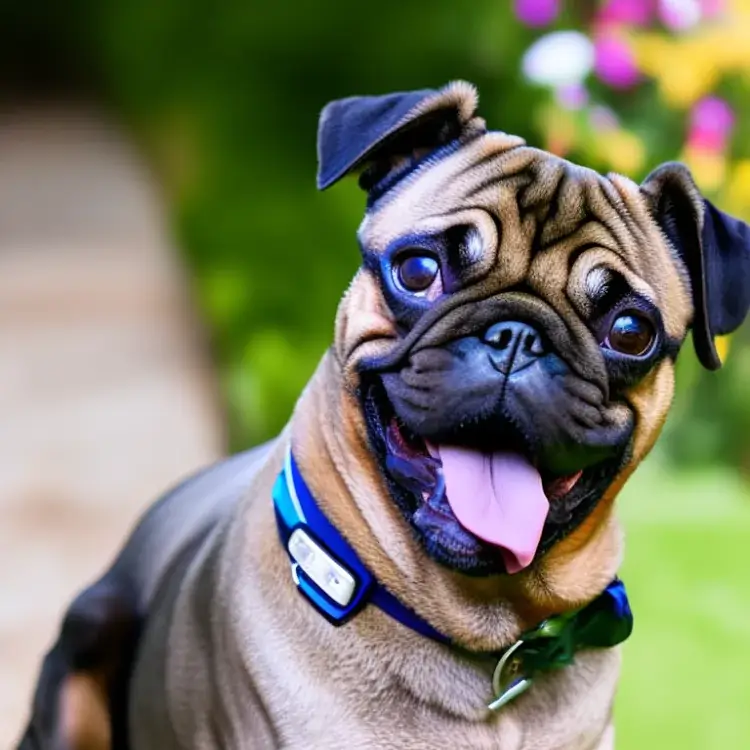
Puggleman dogs may have physical traits from both breeds mixed together, like a stocky build and a lean, muscular build. They might have a smooth, short coat that comes in black, brown, fawn, or brindle, among other colors.
Puggleman dogs may exhibit characteristics from both parent breeds in terms of temperament. Like Dobermans, they may be highly intelligent and trainable, but they can also be pug-like in their stubbornness and independence. Early socialization and training can ensure that Puggleman dogs are well-behaved and get along with people, other animals, and children.
Puggleman dogs may need regular grooming and light exercise to maintain healthy, glossy coats. They might be more susceptible to conditions like hip dysplasia, eye issues, and breathing issues that affect both Pugs and Dobermans. To ensure their health and welfare, it is crucial to work with a reputable breeder and to give them the right veterinary care.
4. Pugapoo dog

The Pugapoo is an offspring of the pug and the poodle. These dogs must be regularly groomed due to their curly, non-shedding coat. They are friendly dogs who enjoy interacting with people. Pugapoos are extremely smart and trainable, and they typically get along well with kids and other animals.
These tiny dogs typically measure between 8 and 15 inches tall and weigh between 10 and 20 pounds. They have a wavy or curly coat that comes in black, brown, cream, and white, among other colors.
The Pugapoo is a mixed breed, so it can have characteristics from either parent breed. They make wonderful companions for families with children or other pets because they are typically sociable and affectionate dogs. Pugapoos are renowned for their playful dispositions and love of social interaction.
Pugapoos are small and don’t need a lot of space to be happy, making them ideal for apartment living. They need daily exercise, such as a walk or some playtime in a fenced yard, because they are vivacious.It’s crucial to have regular veterinary checkups to ensure their wellbeing and identify any issues early.
Pugapoos are typically healthy dogs, but they can be vulnerable to certain conditions like allergies, eye problems, and dental problems. Regular brushing and bathing can help prevent some of these problems through proper grooming.
VI – Facts about the Puggle Dog
- Puggle dogs are a crossbreed between a Pug and a Beagle;
- They are known for their friendly and affectionate personalities;
- Puggles come in a variety of colors, including fawn, black, and tan;
- These dogs typically weigh between 15-30 pounds and have a lifespan of around 10-15 years;
- Puggles may be prone to certain health issues, such as hip dysplasia and respiratory problems, due to their mixed breed status;
- They are popular family pets due to their playful nature and adaptability to different living situations.
1. Are puggles hypoallergenic?
Due to their short, dense coats and seasonal moderate shedding, pugs are not hypoallergenic dogs. Due to their low dander production, puggles may help some allergy sufferers more than other breeds. If you or a member of your family has allergies, it is always advised to get to know any dog breed before bringing it into your home. This goes double for puggles.
2. Are puggles intelligent?
Puggles are frequently thought of as intelligent canines. Although the intelligence of mixed breeds can vary depending on which parent breed they exhibit the most intelligence in, they are frequently trainable and can pick up a wide range of commands and tricks. Puggles can be quite curious and like to solve problems, which makes them a fun and interesting companion. However, it’s crucial to keep in mind that every dog has a distinctive personality and level of intelligence, so some puggles may be smarter than others.
3. National Puggle Day
National Pug Day is a day set aside to honor the adored Pug dog breed. People have loved pugs for centuries and have long admired them for their friendly dispositions, wrinkled faces, and curly tails.
Every year on October 15th, Americans celebrate National Pug Day. On this day, pug owners and admirers across the nation take the time to pay tribute to these adorable little dogs. Some owners give their pugs festive outfits or treats, while others take them for walks or to the neighborhood dog park.
Additionally, on this day, pug rescue groups have the chance to spread the word about the value of adopting and fostering pugs in need. Due to abandonment, neglect, or medical issues, many pugs find themselves in shelters or rescue groups. National Pug Day can serve as a gentle reminder to shower these adorable canines with extra affection and attention, as well as to donate to charities that help them find homes.
On National Pug Day, some people not only honor Pugs but also Pug hybrids like the Puggle, Chug, and Pugapoo. These adorable hybrids are a favorite among dog lovers because they combine the best qualities of both parent breeds.

